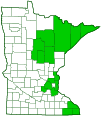common speedwell
(Veronica officinalis var. officinalis)
Conservation • Wetland • Description • Habitat • Ecology • Use • Distribution • Taxonomy
Description |
||
Common speedwell is a common exotic weed. It is native to Europe and Asia. It was introduced into North America as an ornamental, escaped cultivation, and is now naturalized in two widely separated ranges. The eastern population extends from Maine to Minnesota south to North Carolina and Missouri, and in Canada from New Brunswick to Ontario. The western population extends from Washington and Oregon to Montana and Wyoming, and in Canada from British Columbia to Alberta. Common speedwell is an erect, perennial forb that rises on a single stem from fibrous roots. The stem is up to 16″ long, lies flat on the ground,and is slightly curved upward (ascending) at the tip. At intervals it produces a small swelling (node). Fibrous roots develop on the lower side of the node and single branch rises from the upper side. It often forms dense mats. The stem is green and is densely and uniformly covered with spreading, non-glandular hairs. The branches are erect or ascending, 2″ to 10″ tall, green, leafy, and densely and uniformly covered with spreading, non-glandular hairs. The leaves are opposite, ⅝″ to 2″ (15 to 50 mm) long, ¼″ to 1 3 ⁄16″ (6 to 30 mm) wide, about 1½ to 3 times as long as wide. The leaf blades are elliptic (widest at the middle) or inversely egg-shaped (widest slightly above the middle), angled to a short stalk at the base, and rounded or bluntly pointed at the tip. The upper and lower surfaces are moderately to densely covered with soft, spreading, non-glandular hairs. The margins are finely toothed, the larger leaves with 12 to 20 teeth per side. The inflorescence is usually a solitary, spike-like, unbranched cluster (raceme) of several flowers rising from only the upper leaf axils. Occasionally there are two racemes rising from the same leaf axil. The small flowers are on 1 ⁄32″ to 1 ⁄16″ (1 to 2 mm) long stalks (pedicels). At the base of each pedicel there is single small modified leaf (bract). The bract is green, narrowly lance-shaped, and longer than the pedicel. It is covered with spreading, gland-tipped hairs. Each flower is ¼″ to ⅜″ in diameter. There are 4 outer floral leaves (sepals), 4 petals, 2 stamens, and 1 style. The sepals are green, ⅛″ to ¼″ (4 to 6 mm) long, and covered with spreading gland-tipped hairs. They are fused at the base into a short calyx tube, then separated into 4 lance-shaped lobes. The petals are light blue or lavender with dark veins. They are fused at the base into a short tube then separated into 4 lobes that are much longer than the tube. The upper three lobes are round to egg-shaped, ⅛″ to 5 ⁄16″ (4 to 8 mm) wide, and about equal in size. The lower petal is as long but much narrower. The stamens have white anthers and project well beyond the petals. The style is ⅛″ (3 to 4 mm) long and also projects well beyond the petals. The fruit is a flattened, yellowish-brown, ⅛″ (4 mm) long, ⅛″ (4 mm) wide, capsule with 12 to 24 tiny seeds. The capsule is broadly triangular or slightly heart-shaped with just a shallow notch at the tip. The surfaces and margin are covered with gland-tipped hairs. |
||
Height |
||
2″ to 10″ |
||
Flower Color |
||
Light blue or lavender with dark veins |
||
Similar Species |
||
Habitat |
||
Dry. Abandoned fields, upland woodlands, roadsides, and disturbed areas. |
||
Ecology |
||
Flowering |
||
April to July |
||
Pests and Diseases |
||
|
||
Use |
||
|
||
Distribution |
||||
|
Sources |
|||
| 4/1/2023 | ||||
Nativity |
||||
Native to Europe and Asia. Introduced and naturalized in North America. |
||||
Occurrence |
||||
Uncommon in Minnesota |
||||
Taxonomy |
|||
| Kingdom | Plantae (Plants) | ||
| Division | Tracheophyta (Vascular Plants) | ||
| Subdivision | Spermatophytina (Seed Plants) | ||
| Class | Magnoliopsida (Dicots) | ||
Order |
Lamiales (Mints, Plantains, Olives, and Allies) | ||
Family |
Plantaginaceae (plantain) | ||
| Tribe | Veroniceae | ||
| Genus | Veronica (speedwells) | ||
| Subgenus | Veronica | ||
| Species | Veronica officinalis (heath speedwell) | ||
Synonyms |
|||
Veronica tournefortii Veronica officinalis var. tournefortii |
|||
Common Names |
|||
common gypsyweed common speedwell gypsyweed health speedwell speedwell upland speedwell |
|||
Glossary
Ascending
Growing upward at an angle or curving upward from the base.
Axil
The upper angle where a branch, stem, leaf stalk, or vein diverges.
Bract
Modified leaf at the base of a flower stalk, flower cluster, or inflorescence.
Calyx
The group of outer floral leaves (sepals) below the petals, occasionally forming a tube.
Glandular hairs
Hairs spread over aerial vegetation that secrete essential oils. The oils act to protect against herbivores and pathogens or, when on a flower part, attract pollinators. The hairs have a sticky or oily feel.
Node
The small swelling of the stem from which one or more leaves, branches, or buds originate.
Pedicel
On plants: the stalk of a single flower in a cluster of flowers. On insects: the second segment of the antennae. On Hymenoptera and Araneae: the narrow stalk connecting the thorax to the abdomen: the preferred term is petiole.
Raceme
An unbranched, elongated inflorescence with stalked flowers. The flowers mature from the bottom up.
Sepal
An outer floral leaf, usually green but sometimes colored, at the base of a flower.
Visitor Photos |
|||||
Share your photo of this plant. |
|||||
| This button not working for you? Simply email us at info@MinnesotaSeasons.com. Attach one or more photos and, if you like, a caption. |
|||||
|
|||||
MinnesotaSeasons.com Photos |
|||||
Mat |
|||||
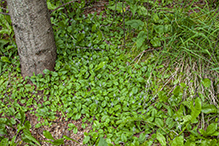 |
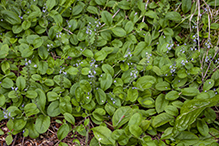 |
||||
Plants |
|||||
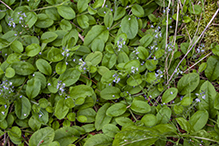 |
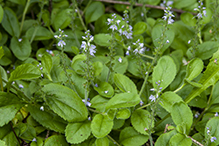 |
||||
Inflorescence |
|||||
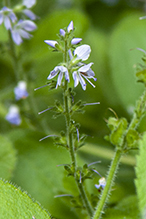 |
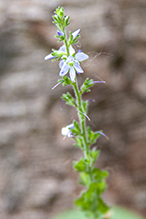 |
||||
Leaves |
|||||
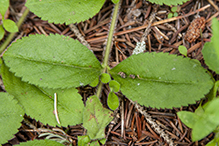 |
|||||
Flowering Branch |
|||||
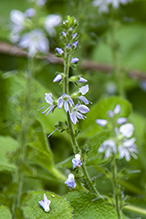 |
|||||
Creeping Stem |
|||||
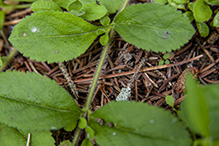 |
|||||

Slideshows |
||

Visitor Videos |
|||
Share your video of this plant. |
|||
| This button not working for you? Simply email us at info@MinnesotaSeasons.com. Attach a video, a YouTube link, or a cloud storage link. |
|||
Other Videos |
|||
| Rozrazil lékařský - Veronica officinalis jaromírhodan s |
|||
About
Jul 8, 2019 Veronica officinalis |
|||
| Mannetjes ereprijs Veronica officinalis 14 juni 2013 florinegreen70 |
|||
About
Jun 13, 2013 Minder grote bloemen dan de gewone ereprijs, kleur meer paars dan blauw, soms heel licht. Drogere standplaatsen, veel op zandgrond. |
|||

Visitor Sightings |
|||||
Report a sighting of this plant. |
|||||
| This button not working for you? Simply email us at info@MinnesotaSeasons.com. Be sure to include a location. |
|||||
|
|||||
MinnesotaSeasons.com Sightings |
|||||

Created: 12/18/2019
Last Updated:
